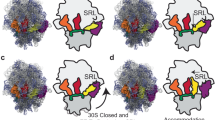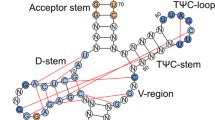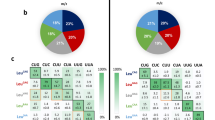Abstract
Accurate discrimination between cognate and near-cognate aminoacyl-tRNAs during translation relies on the specific acceleration of forward rate constants for cognate tRNAs. Such specific rate enhancement correlates with conformational changes in the tRNA and small ribosomal subunit that depend on an RNA-specific type of interaction, the A-minor motif, between universally conserved 16S ribosomal RNA nucleotides and the cognate codon-anticodon helix. We show that perturbations of these two components of the A-minor motif, the conserved rRNA bases and the codon-anticodon helix, result in distinct outcomes. Although both cause decreases in the rates of tRNA selection that are rescued by aminoglycoside antibiotics, only disruption of the codon-anticodon helix is overcome by a miscoding tRNA variant. On this basis, we propose that two independent molecular requirements must be met to allow tRNAs to proceed through the selection pathway, providing a mechanism for exquisite control of fidelity during this step in gene expression.
This is a preview of subscription content, access via your institution
Access options
Subscribe to this journal
Receive 12 print issues and online access
$189.00 per year
only $15.75 per issue
Buy this article
- Purchase on Springer Link
- Instant access to full article PDF
Prices may be subject to local taxes which are calculated during checkout




Similar content being viewed by others
References
Rodnina, M.V. & Wintermeyer, W. Fidelity of aminoacyl-tRNA selection on the ribosome: kinetic and structural mechanisms. Annu. Rev. Biochem. 70, 415–435 (2001).
Ogle, J.M. & Ramakrishnan, V. Structural insights into translational fidelity. Annu. Rev. Biochem. 74, 129–177 (2005).
Gromadski, K.B. & Rodnina, M.V. Kinetic determinants of high-fidelity tRNA discrimination on the ribosome. Mol. Cell 13, 191–200 (2004).
Pape, T., Wintermeyer, W. & Rodnina, M.V. Induced fit in initial selection and proofreading of aminoacyl-tRNA on the ribosome. EMBO J. 18, 3800–3807 (1999).
Hopfield, J.J. Kinetic proofreading: a new mechanism for reducing errors in biosynthetic processes requiring high specificity. Proc. Natl. Acad. Sci. USA 71, 4135–4139 (1974).
Ninio, J. Kinetic amplification of enzyme discrimination. Biochimie 57, 587–595 (1975).
Ogle, J.M. et al. Recognition of cognate transfer RNA by the 30S ribosomal subunit. Science 292, 897–902 (2001).
Ogle, J.M., Murphy, F.V., Tarry, M.J. & Ramakrishnan, V. Selection of tRNA by the ribosome requires a transition from an open to a closed form. Cell 111, 721–732 (2002).
Carter, A.P. et al. Functional insights from the structure of the 30S ribosomal subunit and its interactions with antibiotics. Nature 407, 340–348 (2000).
Gromadski, K.B. & Rodnina, M.V. Streptomycin interferes with conformational coupling between codon recognition and GTPase activation on the ribosome. Nat. Struct. Mol. Biol. 11, 316–322 (2004).
Pape, T., Wintermeyer, W. & Rodnina, M.V. Conformational switch in the decoding region of 16S rRNA during aminoacyl-tRNA selection on the ribosome. Nat. Struct. Biol. 7, 104–107 (2000).
Rodnina, M.V., Pape, T., Fricke, R., Kuhn, L. & Wintermeyer, W. Initial binding of the elongation factor Tu·GTP·aminoacyl-tRNA complex preceding codon recognition on the ribosome. J. Biol. Chem. 271, 646–652 (1996).
Yusupov, M.M. et al. Crystal structure of the ribosome at 5.5 Å resolution. Science 292, 883–896 (2001).
Cukras, A.R. & Green, R. Multiple effects of S13 in modulating the strength of intersubunit interactions in the ribosome during translation. J. Mol. Biol. 349, 47–59 (2005).
Liiv, A. & O'Connor, M. Mutations in the intersubunit bridge regions of 23S rRNA. J. Biol. Chem. 281, 29850–29862 (2006).
Cochella, L. & Green, R. An active role for tRNA in decoding beyond codon:anticodon pairing. Science 308, 1178–1180 (2005).
Piepenburg, O. et al. Intact aminoacyl-tRNA is required to trigger GTP hydrolysis by elongation factor Tu on the ribosome. Biochemistry 39, 1734–1738 (2000).
Favre, A., Buchingham, R. & Thomas, G. tRNA tertiary structure in solution as probed by the photochemically induced 8–13 cross-link. Nucleic Acids Res. 2, 1421–1431 (1975).
Holbrook, S.R., Sussman, J.L., Warrant, R.W. & Kim, S.H. Crystal structure of yeast phenylalanine transfer RNA. II. Structural features and functional implications. J. Mol. Biol. 123, 631–660 (1978).
Vacher, J. & Buckingham, R.H. Effect of photochemical crosslink S4U(8)-C(13) on suppressor activity of su+ tRNATrp from Escherichia coli. J. Mol. Biol. 129, 287–294 (1979).
Valle, M. et al. Incorporation of aminoacyl-tRNA into the ribosome as seen by cryo-electron microscopy. Nat. Struct. Biol. 10, 899–906 (2003).
Doherty, E.A., Batey, R.T., Masquida, B. & Doudna, J.A. A universal mode of helix packing in RNA. Nat. Struct. Biol. 8, 339–343 (2001).
Noller, H.F. RNA structure: reading the ribosome. Science 309, 1508–1514 (2005).
Battle, D.J. & Doudna, J.A. Specificity of RNA-RNA helix recognition. Proc. Natl. Acad. Sci. USA 99, 11676–11681 (2002).
Gromadski, K.B., Daviter, T. & Rodnina, M.V. A uniform response to mismatches in codon-anticodon complexes ensures ribosomal fidelity. Mol. Cell 21, 369–377 (2006).
Powers, T. & Noller, H.F. Dominant lethal mutations in a conserved loop in 16S rRNA. Proc. Natl. Acad. Sci. USA 87, 1042–1046 (1990).
Yoshizawa, S., Fourmy, D. & Puglisi, J.D. Recognition of the codon-anticodon helix by ribosomal RNA. Science 285, 1722–1725 (1999).
Abdi, N.M. & Fredrick, K. Contribution of 16S rRNA nucleotides forming the 30S subunit A and P sites to translation in Escherichia coli. RNA 11, 1624–1632 (2005).
Youngman, E.M., Brunelle, J.L., Kochaniak, A.B. & Green, R. The active site of the ribosome is composed of two layers of conserved nucleotides with distinct roles in peptide bond formation and peptide release. Cell 117, 589–599 (2004).
Youngman, E.M. & Green, R. Affinity purification of in vivo-assembled ribosomes for in vitro biochemical analysis. Methods 36, 305–312 (2005).
Pape, T., Wintermeyer, W. & Rodnina, M.V. Complete kinetic mechanism of elongation factor Tu-dependent binding of aminoacyl-tRNA to the A site of the E. coli ribosome. EMBO J. 17, 7490–7497 (1998).
Hirsh, D. Tryptophan transfer RNA as the UGA suppressor. J. Mol. Biol. 58, 439–458 (1971).
Fahlman, R.P., Olejniczak, M. & Uhlenbeck, O.C. Quantitative analysis of deoxynucleotide substitutions in the codon-anticodon helix. J. Mol. Biol. 355, 887–892 (2006).
Phelps, S.S., Jerinic, O. & Joseph, S. Universally conserved interactions between the ribosome and the anticodon stem-loop of A site tRNA important for translocation. Mol. Cell 10, 799–807 (2002).
Potapov, A.P., Triana-Alonso, F.J. & Nierhaus, K.H. Ribosomal decoding processes at codons in the A or P sites depend differently on 2'-OH groups. J. Biol. Chem. 270, 17680–17684 (1995).
Recht, M.I., Fourmy, D., Blanchard, S.C., Dahlquist, K.D. & Puglisi, J.D. RNA sequence determinants for aminoglycoside binding to an A-site rRNA model oligonucleotide. J. Mol. Biol. 262, 421–436 (1996).
Blanchard, S.C., Gonzalez, R.L., Kim, H.D., Chu, S. & Puglisi, J.D. tRNA selection and kinetic proofreading in translation. Nat. Struct. Mol. Biol. 11, 1008–1014 (2004).
Gourse, R.L., Takebe, Y., Sharrock, R.A. & Nomura, M. Feedback regulation of rRNA and tRNA synthesis and accumulation of free ribosomes after conditional expression of rRNA genes. Proc. Natl. Acad. Sci. USA 82, 1069–1073 (1985).
Acknowledgements
We thank E. Youngman for developing the ribosome tagging and purification methodology, K. Gromadski and M. Rodnina for their technical advice, J. Lorsch, C. Merryman and E. Youngman for their comments and suggestions on the manuscript and O. Uhlenbeck, V. Ramakrishnan and G. Seydoux for valuable comments and discussions. We also thank the US National Institutes of Health for funding of the project and the Howard Hughes Medical Institute for salary support to R.G.
Author information
Authors and Affiliations
Corresponding author
Ethics declarations
Competing interests
The authors declare no competing financial interests.
Supplementary information
Supplementary Fig. 1
Saturating ribosome concentration in GTP hydrolysis reactions. (PDF 48 kb)
Supplementary Fig. 2
Dipeptide formation with excess ternary complex relative to ribosomes. (PDF 58 kb)
Supplementary Fig. 3
Saturating paromomycin concentration in dipeptide formation reactions. (PDF 48 kb)
Rights and permissions
About this article
Cite this article
Cochella, L., Brunelle, J. & Green, R. Mutational analysis reveals two independent molecular requirements during transfer RNA selection on the ribosome. Nat Struct Mol Biol 14, 30–36 (2007). https://doi.org/10.1038/nsmb1183
Received:
Accepted:
Published:
Issue Date:
DOI: https://doi.org/10.1038/nsmb1183
This article is cited by
-
Ensemble cryo-EM elucidates the mechanism of translation fidelity
Nature (2017)
-
How EF-Tu can contribute to efficient proofreading of aa-tRNA by the ribosome
Nature Communications (2016)
-
Pathways of Genetic Code Evolution in Ancient and Modern Organisms
Journal of Molecular Evolution (2015)
-
Prediction of uridine modifications in tRNA sequences
BMC Bioinformatics (2014)
-
GTPase activation of elongation factor EF-Tu by the ribosome during decoding
The EMBO Journal (2009)



